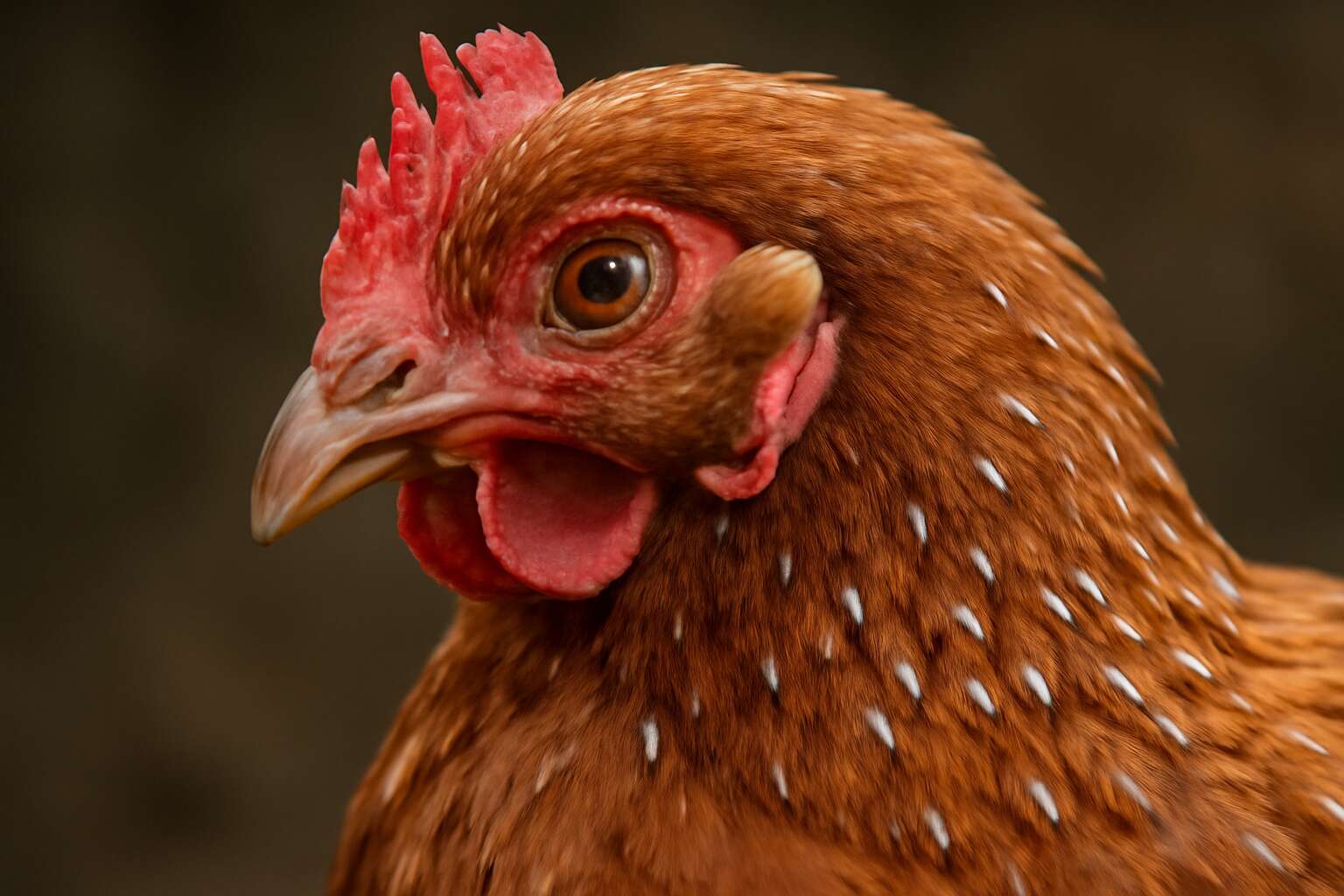Understanding Poultry Lice
What Are Poultry Lice?
Poultry lice are tiny, resilient parasites that have persisted alongside humans for centuries, silently infiltrating farms and backyard coops alike. These unwelcome guests cling to chickens’ feathers and skin, feeding on their blood and causing discomfort that can quickly escalate if left unchecked. Their presence often goes unnoticed until symptoms such as feather loss, restlessness, or pale combs appear—signs that reveal the parasitic invasion beneath the surface.
Understanding what poultry lice are is essential, especially when considering the question: can poultry lice kill chickens? While these pests may seem insignificant, their impact can be devastating if not addressed promptly. Poultry lice are more than just a nuisance; they can weaken a flock’s immune system, lead to secondary infections, and, in extreme cases, contribute to the decline and death of affected birds. Recognizing these parasites early is crucial in safeguarding the health of your chickens and ensuring they thrive in their natural environment.
Types of Poultry Lice
Understanding the intricacies of poultry lice reveals a fascinating yet troubling aspect of avian parasitology. These minuscule, resilient parasites come in several distinct forms, each with unique adaptations that influence their impact on chicken health. The two most common types encountered in South African farms are the *menacanthus* and *mallophaga* lice, both of which have evolved to exploit their host with remarkable efficiency. Their presence often goes unnoticed until the subtle signs of distress emerge—feather pecking, irritation, or anemia—yet their silent invasion can be far more insidious than it appears.
In fact, the question “can poultry lice kill chickens?” is more nuanced than a simple yes or no. While they rarely cause death outright, their relentless feeding can weaken a bird’s immune defenses, making it vulnerable to secondary infections. The parasitic assault can progress to a point where the chicken’s vitality diminishes significantly, sometimes culminating in death if the infestation becomes severe. This underscores the importance of recognizing the different types of poultry lice and understanding their potential to contribute to mortality in avian populations.
Life Cycle of Poultry Lice
The lifecycle of poultry lice is a relentless dance—an unending cycle of survival and adaptation that often goes unnoticed beneath the shimmering feathers of our resilient chickens. These tiny parasites, invisible to the naked eye, undergo a series of transformative stages that enable them to thrive in their avian hosts. It is this very cycle that raises the question: can poultry lice kill chickens? The answer is layered, for in their silent invasion, they weaken the bird’s defenses over time, making mortality a grim possibility if left unchecked.
Understanding the life cycle of poultry lice reveals a complex interplay of stages, each vital to their persistence. From eggs laid in the feather shafts to nymphs that hatch and quickly seek to feed, their journey is swift and efficient. The entire process, often spanning just a few weeks, allows these parasites to multiply rapidly, especially in warm, humid environments typical of South African farms.
- Eggs hatch into nymphs
- Nymphs mature through several instars
- Adults emerge ready to feed and reproduce
During this cycle, the relentless feeding of poultry lice can lead to anemia and stress, subtly eroding the vitality of the chickens. While they rarely cause death directly, the cumulative toll can be devastating, especially when secondary infections take hold. Their insidious presence underscores the importance of early detection and treatment, for the question remains—can poultry lice kill chickens? The answer hinges on timing and intervention, for their destructive potential is often underestimated until it’s too late.
Can Poultry Lice Kill Chickens?
Potential Health Risks Posed by Poultry Lice
Contrary to popular misconception, poultry lice are not the silent killers of the avian world, but their presence can silently erode a chicken’s vitality. While they generally do not directly cause death, the question lingers: can poultry lice kill chickens? The answer is nuanced. Severe infestations can lead to anemia, weight loss, and a weakened immune system, making chickens susceptible to secondary infections that may prove fatal. It’s a subtle yet insidious threat, often underestimated by those who believe lice are merely a nuisance.
In reality, the health risks posed by poultry lice extend beyond mere discomfort. Chronic irritation can cause pecking and cannibalism, further jeopardizing flock health. For those raising chickens in South Africa’s diverse climate, the stakes are even higher, as environmental factors can exacerbate the situation. While poultry lice are unlikely to be a swift executioner, persistent infestations can indeed push a fragile bird toward the brink. Ultimately, the question remains—can poultry lice kill chickens? The answer hinges on the severity of the infestation and the resilience of the bird itself.
Signs and Symptoms of Severe Infestation
While poultry lice are often dismissed as mere nuisances, their impact can be far more serious than many realize. The question lingers—can poultry lice kill chickens? The answer is complex, but understanding the signs of a severe infestation is crucial for any farmer or bird enthusiast in South Africa. When lice populations become overwhelming, they drain vital nutrients from the bird, leading to anemia and weight loss. These symptoms are often subtle at first but can escalate rapidly if left untreated.
Signs of a severe infestation include persistent scratching, bald patches, and a noticeable decrease in egg production. Chickens may also exhibit lethargy and a reluctance to move, hinting at underlying suffering. In some cases, poultry lice can cause enough distress to weaken the immune system, making birds more vulnerable to secondary infections.
- Severe anemia
- Persistent fatigue
- Weight loss
These symptoms underscore the importance of early detection and intervention to prevent a tragic outcome. While poultry lice typically do not cause immediate death, their relentless presence can push a resilient bird towards the brink of collapse, especially in challenging environments like South Africa’s diverse climate.
Case Studies and Expert Opinions
The unsettling truth is that poultry lice, often perceived as mere pests, can indeed have more dire consequences than many realize. While they rarely cause instant death, the question remains—can poultry lice kill chickens? The answer is nuanced. Severe infestations can weaken a bird’s immune system, leading to profound health challenges. In some cases, the relentless drain on nutrients and blood can push a resilient chicken to the brink of collapse.
Several case studies across South Africa have shown that untreated outbreaks can exacerbate health issues, sometimes resulting in mortality. Experts agree that while poultry lice are not typically lethal on their own, their capacity to foster secondary infections and anemia can be fatal if overlooked. A poultry farmer once remarked, “It’s not just about scratching; it’s about survival.” The presence of lice, especially in high numbers, can cause enough stress and physical depletion to threaten a chicken’s life. This underscores the importance of vigilance and early intervention in safeguarding flock health.
Factors Influencing the Severity of Infestations
Environmental Conditions
Environmental conditions play a pivotal role in determining the severity of poultry lice infestations. Warm, humid climates—common in many South African regions—create an ideal breeding ground for these resilient parasites. When temperatures hover between 20°C and 30°C, and moisture levels are consistently high, the lice’s life cycle accelerates, leading to rapid population growth. This raises an important question: can poultry lice kill chickens? The answer is nuanced; while they rarely cause death outright, severe infestations can weaken chickens significantly, making them vulnerable to other health issues.
Factors such as overcrowding, poor ventilation, and inadequate sanitation can exacerbate infestation severity. These conditions trap moisture and provide ample hiding spots for lice, allowing their numbers to multiply unchecked. Recognizing these environmental influences is crucial, especially when managing farms in regions where climate conditions favor parasite proliferation. In such settings, vigilance becomes the best defense against the silent threat of poultry lice, which—if left unchecked—may contribute to the decline of flock health over time.
Age and Health of Chickens
The health and resilience of chickens are often underestimated in the face of persistent parasites like poultry lice. Age and overall health are critical factors that influence how severely an infestation impacts a flock. Young chicks with developing immune systems are especially vulnerable. Their delicate physiology struggles to fend off the constant irritation and blood loss caused by lice, making them more susceptible to secondary infections.
Older chickens, while generally better equipped to handle parasites, are not immune. Chronic infestations can drain their vitality, reduce egg production, and leave them exposed to other diseases. The question of can poultry lice kill chickens is nuanced — outright death is rare, but weakened birds are more prone to complications. In regions like South Africa, where climate fosters rapid lice proliferation, understanding how age and health influence infestation severity is vital for effective management.
Farm Management Practices
Farm management practices wield significant influence over the severity of poultry lice infestations. In regions like South Africa, where climatic conditions create a breeding ground for rapid lice proliferation, meticulous oversight becomes crucial. Proper sanitation, regular cleaning of poultry houses, and strategic use of insecticides can dramatically reduce lice populations, lowering the risk of severe infestations.
Implementing a rigorous pest control schedule helps keep infestations in check, but the true game-changer lies in understanding how farm routines impact parasite dynamics. For instance, overcrowding and poor ventilation not only stress chickens but also create ideal environments for lice to thrive. This can lead to a vicious cycle: increased lice burden weakens the birds, making them more susceptible to secondary infections. While can poultry lice kill chickens is a question often asked, the real danger lies in how infestations drain vitality and open doors to complications.
Farmers should consider a layered approach, such as:
- Maintaining dry, clean bedding
- Implementing rotational grazing or housing
- Monitoring flock health vigilantly
Each of these practices influences how intensely poultry lice affect the flock, underscoring the importance of proactive farm management in safeguarding chicken health and productivity in South Africa’s unique environment.
Prevention of Poultry Lice Infestations
Regular Inspection and Monitoring
In the bustling world of poultry farming, vigilance is your best friend—especially when it comes to preventing poultry lice infestations. While these tiny tormentors might seem harmless at first, they can quickly turn into a nightmare that raises the question: can poultry lice kill chickens? The answer isn’t a simple yes or no, but neglecting prevention can indeed lead to severe health consequences for your flock.
Regular inspection and monitoring are essential tools in the poultry owner’s arsenal. Think of it as giving your chickens a health check-up—minus the stethoscopes. By routinely examining your birds and their environment, you catch signs of lice early before they establish a foothold. This proactive approach not only curtails the spread but also reduces the risk of a full-blown infestation that might threaten your chickens’ lives.
Implementing a structured monitoring routine can be as straightforward as keeping a checklist. For instance, consider using a simple
- visual inspection
- dusting with insecticidal powder
regimen. These small steps, combined with vigilant oversight, create a formidable barrier against poultry lice, ensuring your chickens stay healthy and productive. Remember, in the battle against poultry lice, prevention isn’t just better than cure—it’s the only way to keep your flock thriving in the South African sun.
Maintaining Cleanliness in Coop Areas
Keeping your poultry coop spotless isn’t just about aesthetics—it’s a vital line of defense against poultry lice infestations. A dirty environment can turn into a breeding ground for these unwelcome guests, making your flock vulnerable. Regularly cleaning and disinfecting coop areas helps eliminate the eggs and nymphs lurking in corners, bedding, and feed troughs. After all, can poultry lice kill chickens? Yes, if left unchecked, but a clean coop significantly reduces this risk.
Implementing a strict cleanliness routine involves more than just sweeping out old straw. It’s about creating an inhospitable environment for lice to thrive. Consider using natural repellents and ensuring good ventilation to discourage pests. For added security, some poultry farmers in South Africa swear by dusting their chickens with insecticidal powders during routine cleaning—an effective method to keep lice at bay. Remember, a well-maintained coop isn’t just hygienic; it’s a fortress protecting your feathered friends from the threat of severe infestations that could potentially kill chickens if ignored long enough.
In the battle against poultry lice, maintaining cleanliness is your frontline strategy. Here are some tips to keep your coop pristine:
- Remove soiled bedding regularly—think of it as giving your chickens a spa day, minus the cucumber slices.
- Disinfect feeders, waterers, and nesting boxes to prevent lice from hitchhiking onto your birds.
- Ensure proper ventilation to reduce humidity levels, which favor the lifecycle of poultry lice.
Use of Protective Barriers and Treatments
Preventing poultry lice infestations starts with strategic barriers and targeted treatments. Using protective barriers such as fine mesh screens around ventilation points or nesting areas can physically block lice from reaching your chickens. These barriers are a simple yet effective line of defense, especially in environments prone to high pest activity.
In addition, applying natural treatments can bolster your efforts. Diatomaceous earth or neem-based powders, when dusted onto chickens and coop surfaces, create an inhospitable environment for lice. Regularly treating the coop and birds reduces the risk of a severe infestation that could lead to illness or even death. After all, can poultry lice kill chickens? Yes, if the infestation becomes severe and unchecked. That’s why combining physical barriers with natural treatments forms a comprehensive prevention plan.
- Implement physical barriers to block entry points.
- Use natural insecticidal powders during routine cleaning.
- Apply treatments consistently to prevent lice from establishing.
Treatment Options for Poultry Lice
Chemical Treatments
When confronting the insidious threat of poultry lice, many wonder, can poultry lice kill chickens? The answer is complex; while not always lethal, severe infestations can weaken a bird’s immune system, making them vulnerable to secondary infections. Chemical treatments offer a potent line of defense, but their application requires careful consideration. These treatments typically involve pesticides that target lice at various life stages, disrupting their reproduction cycle and reducing their population effectively.
However, the selection of chemical remedies must be approached with caution. Overuse or improper application can lead to resistance, rendering treatments ineffective and risking harm to the flock. For this reason, integrated pest management—combining chemical treatments with environmental adjustments—often yields the best results.
- Insecticidal sprays
- Dust powders
- Pour-on formulations
are commonly used, but always follow the manufacturer’s instructions meticulously to ensure safety for both chickens and humans. The goal is to suppress the lice population without compromising the health of your poultry or the integrity of your farm environment.
Natural Remedies
Natural remedies for poultry lice provide a gentle yet effective alternative to chemical treatments, especially for farmers seeking eco-friendly solutions. While some may wonder, can poultry lice kill chickens? The answer hinges on the severity of the infestation. In mild cases, natural methods can control lice populations and prevent them from causing significant harm. But in severe infestations, the toll on a chicken’s health can be profound, weakening immune defenses and paving the way for secondary infections.
One popular natural approach involves the use of herbal infusions and safe, organic powders. For instance, diatomaceous earth sprinkled in the coop can dehydrate lice upon contact. Additionally, herbal sprays made from neem or eucalyptus oils act as repellents, disrupting lice’ life cycles without risking chemical resistance. Incorporating these remedies into regular farm management practices can bolster your flock’s resilience, making it less likely for lice to reach lethal levels. After all, understanding how to combat poultry lice naturally is a vital part of ensuring your chickens’ well-being and maintaining a thriving farm environment.
Integrated Pest Management Strategies
When contemplating the threat of poultry lice, a pressing question arises: can poultry lice kill chickens? The answer is nuanced. While a mild infestation may merely cause discomfort and reduced productivity, severe infestations can indeed compromise a chicken’s health significantly. Lice weaken the immune system, lead to weight loss, and open the door for secondary infections, potentially culminating in fatalities if left unchecked.
Effective treatment options often involve an integrated pest management strategy that blends natural remedies with targeted interventions. For instance, applying diatomaceous earth in the coop creates a physical barrier that dehydrates lice, while herbal sprays from neem or eucalyptus oils serve as repellents disrupting the lice’s life cycle. Combining these methods with regular monitoring helps maintain a balanced environment where poultry lice are less likely to reach lethal levels.
In addition, farm management practices such as maintaining dry, clean bedding and implementing protective barriers can reduce the risk of infestations. Sometimes, a layered approach is necessary, including:
- Natural repellents
- Environmental sanitation
- Selective chemical treatments when infestations escalate
By employing a comprehensive, adaptable pest management plan, farmers can safeguard their flock’s health and prevent poultry lice from causing devastating outcomes. After all, understanding how to combat poultry lice effectively can determine whether they are merely an annoyance or a genuine threat to your chickens’ lives.
Impact of Poultry Lice on Chicken Health
Behavioral Changes and Discomfort
The impact of poultry lice on chicken health extends far beyond the superficial itchiness or visible irritation. Often underestimated, infestations can trigger profound behavioral changes that compromise a chicken’s well-being and productivity. Chickens subjected to relentless discomfort may become increasingly agitated, pecking at their own feathers or exhibiting signs of distress that hint at deeper suffering. This behavioral shift is not merely a symptom but a reflection of their deteriorating condition, raising the question: can poultry lice kill chickens? The answer is complex. While lice alone are unlikely to be the sole cause of death, their presence can weaken the immune system and open the door to secondary infections that escalate the risk of mortality.
Persistent irritation and distress can lead to a decline in feeding and social interactions, further jeopardizing the health of the flock. Chickens may become lethargic or restless, exhibiting signs of discomfort that interfere with their natural behaviors. In severe cases, the constant stress and blood loss inflicted by poultry lice can push vulnerable birds toward collapse. This ongoing torment underscores the importance of early detection and intervention, as unchecked infestations have the potential to be deadly, especially among young or compromised chickens. Ultimately, understanding the behavioral and physical toll of poultry lice reveals a sobering truth: they can indeed kill chickens if left untreated, turning a manageable pest into a deadly threat.
Secondary Infections and Disease Risks
While poultry lice are often dismissed as mere nuisances, their impact on chicken health can be far more serious than many realize. Infestations weaken the bird’s immune system, making them vulnerable to secondary infections. Bacteria, fungi, and parasites can exploit this compromised state, leading to severe disease outbreaks. These secondary infections not only cause discomfort but can also be fatal in extreme cases.
Chickens suffering from lice-related stress tend to have lower resistance to common diseases, increasing mortality risk. The constant blood loss from lice bites can lead to anemia, further weakening their defenses. In crowded or poorly managed farms, this vulnerability escalates, turning a manageable pest problem into a potential death sentence. It raises an important question: can poultry lice kill chickens? The answer is yes, especially when infestations go unchecked and lead to a cascade of health complications.
Economic Implications for Poultry Keepers
The economic ripple effects of poultry lice infestations extend far beyond mere discomfort for chickens; they threaten the very viability of poultry farming. When infestations become severe, the resulting health deterioration can lead to significant financial losses for farmers. Reduced egg production, lower growth rates, and increased mortality rates all contribute to diminished profitability. Farmers often underestimate the destructive potential of these tiny pests, yet the question remains—can poultry lice kill chickens? The answer is yes, especially when infestations spiral out of control, causing a cascade of health issues that can decimate entire flocks.
Beyond the immediate health implications, the economic burden includes costs associated with treatment, enhanced biosecurity measures, and potential trade restrictions. An unchecked lice infestation can turn a manageable problem into a costly crisis, requiring extensive intervention. For poultry keepers, understanding how these pests impact overall farm productivity underscores the importance of vigilant management practices. In the competitive world of poultry farming, a seemingly small parasite can, ultimately, threaten the sustainability of the entire operation.




0 Comments